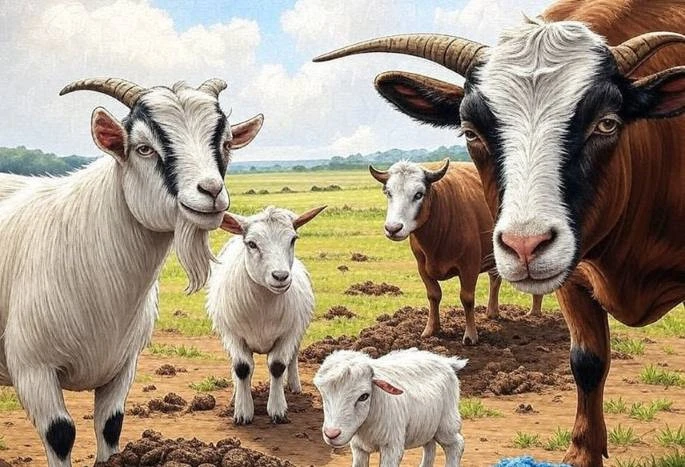MAKASSAR, UNHAS.TV - Organic fertilizers like goat manure and cow dung are widely used in agriculture to enhance soil fertility, improve crop yields, and promote sustainable farming. While both are effective natural fertilizers, they differ in nutrient content, physical properties, decomposition rates, and application suitability. This article explores these differences and provides insights into their use as fertilizers, supported by references.
1. NUTRIENT CONTENT
Goat Manure:
* Higher Nutrient Concentration: Goat manure is richer in essential nutrients like nitrogen (N), phosphorus (P), and potassium (K) compared to cow dung. On average, goat manure contains approximately 2.7% N, 1.8% P, and 2.3% K (dry weight basis).
* Dry and Concentrated: Goat manure is typically drier and more pelletized, making it a concentrated source of nutrients that requires less volume for application.
* Micronutrients: It also contains higher levels of micronutrients like calcium and magnesium, which are vital for plant growth.
Cow Dung:
* Lower Nutrient Concentration: Cow dung has a lower nutrient profile, with approximately 0.5–1.5% N, 0.4–0.8% P, and 0.5–1.0% K (dry weight basis). Its nutrient content varies depending on the cow's diet and age.
* Higher Organic Matter: Cow dung is rich in organic matter, which improves soil structure and water retention but provides nutrients more slowly.
* Moisture Content: Cow dung is wetter, which dilutes its nutrient concentration compared to goat manure.
Reference:
* Adhikary, S. (2012). "Organic manure as a component of integrated nutrient management." Journal of Crop and Weed, 8(2), 11–15.
* USDA (2020). "Nutrient Content of Organic Manures." United States Department of Agriculture.
2. PHYSICAL PROPERTIES
Goat Manure:
* Pelletized Form: Goat manure comes in small, dry pellets, making it easier to handle, store, and apply. The pellet form reduces odor and allows for even distribution.
* Lower Moisture Content: With a moisture content of around 40–50%, it decomposes faster and is less prone to pathogen growth.
* Less Odor: Its drier nature results in a milder smell compared to cow dung.
Cow Dung:
* Wet and Bulky: Cow dung has a high moisture content (70–80%), making it heavier and more challenging to handle. It often requires drying or composting before application.
* Sticky Texture: Its sticky, clumpy nature can make it harder to spread evenly on fields.
* Stronger Odor: The higher moisture content contributes to a more pronounced odor, which can be a concern in residential areas.
Reference:
* Rao, D. L. N., & Batool, S. (2015). "Organic manures and their role in sustainable agriculture." Indian Journal of Agricultural Sciences, 85(3), 321–328.
3. DECOMPOSITION and NUTRIENT RELEASE
Goat Manure:
* Faster Decomposition: Due to its lower moisture content and higher carbon-to-nitrogen (C:N) ratio, goat manure decomposes more quickly, releasing nutrients faster (within 2–3 months).
* Immediate Impact: Its quick nutrient release makes it ideal for crops requiring rapid nutrient uptake, such as leafy vegetables.
* Lower Risk of Nutrient Leaching: The concentrated form reduces the risk of nutrient runoff during heavy rains.
Cow Dung:
* Slower Decomposition: Cow dung has a higher C:N ratio and moisture content, leading to slower decomposition (4–6 months or more). This makes it a slow-release fertilizer.
* Long-Term Benefits: Its gradual nutrient release is beneficial for long-season crops like grains or fruit trees.
* Composting Requirement: Fresh cow dung often needs composting to reduce pathogens and weed seeds, adding an extra step before application.
Reference:
* Haynes, R. J., & Naidu, R. (1998). "Influence of lime, fertilizer, and manure applications on soil organic matter content and soil physical conditions." Nutrient Cycling in Agroecosystems, 51(2), 123–137.
4. APPLICATION SUITABILITY
Goat Manure:
* Best for Quick-Growing Crops: Its high nutrient content and fast decomposition make it suitable for vegetables, flowers, and short-cycle crops.
* Small-Scale Farming: The concentrated nature means less volume is needed, making it cost-effective for small farms or gardens.
* Dry Regions: Its low moisture content makes it ideal for arid regions where water retention is less of a concern.
Cow Dung:
* Best for Soil Conditioning: Cow dung excels in improving soil structure, aeration, and water-holding capacity, making it ideal for degraded or sandy soils.
* Long-Season Crops: Its slow-release nutrients suit crops like rice, wheat, or orchards that require sustained fertility.
* Large-Scale Farming: Its abundance and lower cost make it practical for large farms, though it requires more labor for handling and composting.
Reference:
* Singh, Y., & Singh, B. (2001). "Efficient management of organic manures for sustainable crop production." Journal of the Indian Society of Soil Science, 49(4), 435–444.
5. ENVIRONMENTAL and PRACTICAL CONSIDERATION
Goat Manure:
* Lower Pathogen Risk: The drier nature and faster decomposition reduce the risk of pathogens and weed seeds.
* Easier Storage: Its pelletized form allows for compact storage without significant odor or pest issues.
* Higher Cost: Goat manure may be less available and more expensive due to smaller herd sizes compared to cattle.
Cow Dung:
* Pathogen Concerns: Fresh cow dung may contain pathogens like E. coli or weed seeds, necessitating proper composting.
* Availability: Cow dung is more widely available and cheaper, especially in regions with large cattle populations.
* Biogas Potential: Cow dung is often used for biogas production, providing an additional benefit before being applied as fertilizer.
Reference:
* Reddy, M. V., & Ohkura, K. (2004). "Nutrient dynamics in organic manures and their role in sustainable agriculture." Archives of Agronomy and Soil Science, 50(3), 235–241.
Conclusion
Both goat manure and cow dung are valuable organic fertilizers, but their suitability depends on the farming context. Goat manure, with its higher nutrient content and faster decomposition, is ideal for quick-growing crops and small-scale applications. Cow dung, with its rich organic matter and slow-release nutrients, excels in soil conditioning and long-term crop nutrition. Farmers should consider crop type, soil conditions, and logistical factors when choosing between the two.
By understanding these differences, farmers can make informed decisions to optimize soil fertility and crop productivity while promoting sustainable agriculture.
References
* Adhikary, S. (2012). "Organic manure as a component of integrated nutrient management." Journal of Crop and Weed, 8(2), 11–15.
* USDA (2020). "Nutrient Content of Organic Manures." United States Department of Agriculture.
* Rao, D. L. N., & Batool, S. (2015). "Organic manures and their role in sustainable agriculture." Indian Journal of Agricultural Sciences, 85(3), 321–328.
* Haynes, R. J., & Naidu, R. (1998). "Influence of lime, fertilizer, and manure applications on soil organic matter content and soil physical conditions." Nutrient Cycling in Agroecosystems, 51(2), 123–137.
* Singh, Y., & Singh, B. (2001). "Efficient management of organic manures for sustainable crop production." Journal of the Indian Society of Soil Science, 49(4), 435–444.
* Reddy, M. V., & Ohkura, K. (2004). "Nutrient dynamics in organic manures and their role in sustainable agriculture." Archives of Agronomy and Soil Science, 50(3), 235–241.(*)





-300x190.webp)






